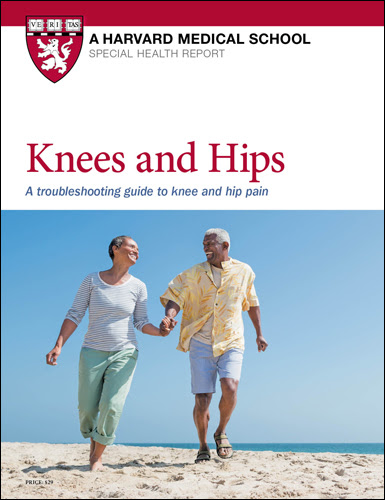Surgery-free pain relief for hips and knees
Hip and knee pain can keep you from the activities you love, as well as make routine tasks difficult. But there are many ways to get you moving again pain-free, without surgery. Here are some of the treatments that can help relieve hip and knee pain.
Get your copy of Knees and Hips: A troubleshooting guide to knee and hip pain
|
| Do your knees or hips hurt? Most people will at some point have knee or hip pain because these large joints have a demanding task: they must bear the full weight of your body while at the same time allowing for a wide range of motion. Wear and tear, injury, and simple genetic predisposition can all contribute to knee or hip pain. This Special Health Report, Knees and Hips: A troubleshooting guide to knee and hip pain, covers a wide range of knee and hip conditions and describes in detail treatments, preventive strategies, and surgeries.
 |
|
Ultrasound, phonophoresis, and iontophoresis
Therapeutic ultrasound is a simple procedure that uses sound waves to increase blood flow, relax muscle spasms, and aid healing that leads to faster hip pain relief and knee pain relief. The therapist applies gel to your skin and moves an ultrasound wand over your skin around the painful area. In a special ultrasound technique called phonophoresis, medication (often hydrocortisone) is added to the gel. In a survey of orthopedic physical therapists, more than half said they would use ultrasound and phonophoresis to reduce soft-tissue inflammation (in tendinitis or bursitis, for example). These techniques are also used to manage pain, heal tissue, and help muscles stretch.
Iontophoresis uses electrical currents to speed the delivery of medication to damaged tissue, or simply to reduce muscle spasms and related irritation. Patches similar to Band-Aids are placed on the skin, and a painless, low-level current is applied for about 10 to 15 minutes. You may feel warmth or tingling during the treatment.
Therapeutic exercise
Strengthening the muscles around a damaged knee or hip can help reduce stress on a joint. For example, your hips have to do less work to support your body weight if your quadriceps, gluteals, hamstrings, and abdominal muscles are strong. Strong quadriceps can also take on some of the shock- absorbing work of the meniscus or cartilage in the knees. The proper balance of strength in the muscles can hold the joint in the most functional and least painful position. Flexibility exercises (to stretch and relax specific muscles) are also an important part of an exercise plan to improve joint function.
Gait retraining
Knee and hip problems can disrupt your normal walk by causing pain, restricting joint movement, or weakening muscles. And a person's normal pattern of standing, walking, or running may invite joint problems. It may take many years of walking with an abnormal gait before joint injury occurs. A physical therapist can analyze your gait and help you learn to move more efficiently. Initially, the "normal" gait may feel odd. It can take practice and continued instruction before it becomes comfortable, but it will eventually become natural for you. Physical therapists may also suggest a change in shoes or ways to strengthen muscles that can help restore a more aligned gait.
For more on strategies for pain-free knees and hips, plus a Special Bonus Section on knee and hip replacement, read Knees and Hips, a Special Health Report from Harvard Medical School.
Image: Guillermo Iosio/iStock
|




No hay comentarios:
Publicar un comentario